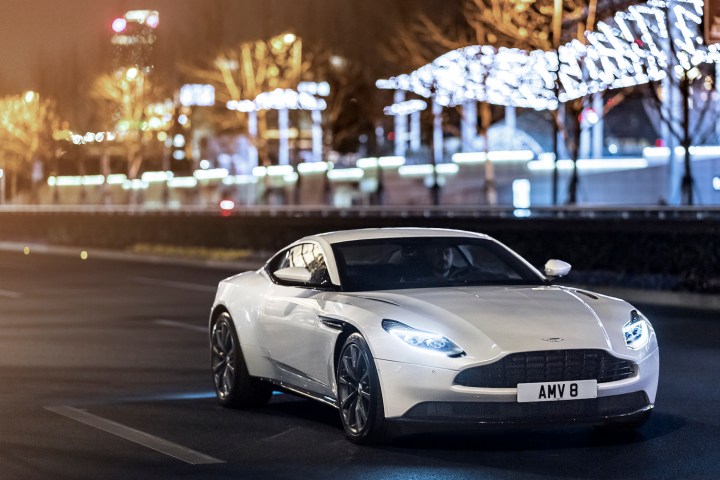
Last year we had a chance to drive the all-new model around the Italian countryside. To say we were impressed would be a severe understatement. If the car’s dashing new exterior design and upscale cabin isn’t enough to wow, its smooth twin-turbocharged V12 engine and sophisticated adaptive suspension will do the trick.
To broaden the appeal of its new GT, Aston Martin will offer three unique versions: A V8-powered iteration, a topless (Volante) model, and the original V12 car. While we’ll have to wait until next year to see the DB11 sans roof, V8 performance is available right now. Drawing from its partnership with Mercedes-Benz, Aston Martin has configured a version of AMG’s 4.0-liter, twin-turbocharged V8 to slot under the clamshell bonnet of the DB11.
Producing 503 horsepower and 513 pound-feet of torque, V8-equipped DB11 sports cars dash to 60 mph in 4.0 seconds (merely a tenth of a second of the V12 car’s pace) and top out at 187 mph (which is a fair ways behind the V12’s 211-mph top end). Aston Martin claims the V8 distinctive power delivery and light weight — 253 pounds less than the 12-cylinder — gives the DB11 a more dynamic edge.

“To be able to offer not one, but two exceptional GT cars is terrific for Aston Martin and our customers,” said Aston Martin chief technical officer Max Szwaj. “I’m particularly proud that this car is the first to receive an engine supplied by our technical partner, Mercedes-AMG.”
Having sampled this engine in a number of AMG vehicles (including the C63 S Coupe and AMG GT S), we can attest to its vicious power and accessible performance. However, Aston Martin has adapted the powertrain to the DB11’s grand touring characteristics. The V8 gains a new ECU (engine control unit), distinct throttle mapping, bespoke air intake, exhaust and wet sump lubrication systems.
Styling tweaks for the V8 model are limited to a unique alloy wheel finish, dark headlamp bezels and a pair of hood vents instead of the quartet featured on the V12 car.
“The DB11 is the most complete and sophisticated car Aston Martin has ever made,” president and CEO Andy Palmer noted. “Now, with this new V8 engine option we have broadened its appeal by offering a car that will bring the DB11 to more customers around the world while still blessed with the exceptional performance and memorable character that sets Aston Martin apart from its rivals.”
The V8-powered Aston Martin DB11 is now on sale at a starting price of $198,995 ($17,500 less than the V12 version), with deliveries towards the end of this year.


